 The Ministry of Finance has adopted a new regulation on requirements for new residential mortgage loans.
The Ministry of Finance has adopted a new regulation on requirements for new residential mortgage loans.
The new regulation replaces the current regulation, which is set to expire at the end of June 2018. The new regulation takes effect from 1 July 2018 and will be in force until 31 December 2019.
The cap on a borrower’s total debt (debt-to-income, DTI) remains at five times the borrower’s gross annual income in the new regulation. Furthermore, the caps on the loan-to-value (LTV) ratio on residential mortgage loans and home equity credit lines remain at 85 and 60 per cent respectively. The amortization requirement for loans with a LTV-ratio above 60 per cent, and the provision that lenders should make allowance for an interest rate increase of 5 percentage points when assessing a borrower’s debt-servicing ability, both remain unchanged in the new regulation.
The regulation allows a certain amount of a lender’s approved loans to deviate from the requirements in the regulation. In the new regulation, this quota remains at 10 per cent of the volume of a lender’s approved loans outside Oslo.
When the current regulation was adopted in December 2016, the Ministry of Finance introduced requirements in the regulation specific to Oslo. In Oslo, the quota for loans that do not meet all requirements in the regulation was reduced to 8 per cent. In addition, the cap on the LTV-ratio on secondary homes in Oslo was reduced to 60 per cent. Both requirements have been retained in the new regulation.
In the new regulation, equity credit release agreements are exempted from the amortization requirement, the DTI-limit and the debt-servicing ability requirement.
Background
In June 2015, the Ministry of Finance adopted a regulation on requirements for new residential mortgage loans. The regulation was based on existing mortgage lending guidelines from the Financial Services Authority. The regulation took effect from 1 July 2015 and expired 31 December 2016. The Ministry of Finance extended and amended the regulation on 14 December 2016. The new regulation took effect 1 January 2017 and will be in force until 30 June 2018.
On 28 February 2018, the Ministry of Finance issued a public consultation on a recommendation from the Financial Services Authority to extend the mortgage regulation with some adjustments. The public consultation ended on 11 April 2018.

 Many of the challenges the world is now facing can only be addressed through cooperation with other countries. The UN is the most important forum for international cooperation. Norway has been a strong supporter, both financially and politically, of the UN’s work to promote peace, development and human rights since the organisation was established in the aftermath of the Second World War.
Many of the challenges the world is now facing can only be addressed through cooperation with other countries. The UN is the most important forum for international cooperation. Norway has been a strong supporter, both financially and politically, of the UN’s work to promote peace, development and human rights since the organisation was established in the aftermath of the Second World War.
 The so-called troika in Sudan (USA, UK and Norway) has delivered a joint statement on the ongoing clashes in the Jebel Marra region of Darfur.
The so-called troika in Sudan (USA, UK and Norway) has delivered a joint statement on the ongoing clashes in the Jebel Marra region of Darfur.
 The government of Sri Lanka distributed drinking water at a very low price and giave priority to the investments made with the participation of government and private sector, SL Minister Rauff Hakeem said.
The government of Sri Lanka distributed drinking water at a very low price and giave priority to the investments made with the participation of government and private sector, SL Minister Rauff Hakeem said.

 “Most of the data about fisheries are extractions based on catches by fishermen. An independent study is required to assess depleting fisheries stocks and find out new fishing grounds. There can also be under-utilised fish stocks that can be harvested successfully, and research would help us to identify such opportunities,” said National Aquatic Resource Research Development Agency (NARA) Deputy Director-General Dr. Palitha Kithsiri.
“Most of the data about fisheries are extractions based on catches by fishermen. An independent study is required to assess depleting fisheries stocks and find out new fishing grounds. There can also be under-utilised fish stocks that can be harvested successfully, and research would help us to identify such opportunities,” said National Aquatic Resource Research Development Agency (NARA) Deputy Director-General Dr. Palitha Kithsiri.
 The State Minister of the Norwegian Ministry of Foreign Affairs Jens Frølich Holte will visit Sri Lanka this week during which he will discuss promotion of ocean-based industries.
The State Minister of the Norwegian Ministry of Foreign Affairs Jens Frølich Holte will visit Sri Lanka this week during which he will discuss promotion of ocean-based industries.
 The United States and its NATO allies continue to find ways to antagonize Russia. The latest provocation is a request from Norway to more than double the number of U.S. troops stationed on its territory and deploy them even closer to the border with Russia. Granted, the numbers involved are not large. There are currently 330 American military personnel in the country on a “rotational” basis. Oslo’s new request would increase the number to seven hundred. If the Norwegian government gets its way, the new troops would be stationed in the far north, barely 260 miles from Russia, in contrast to the existing unit in central Norway, several hundred miles from Russian territory.
The United States and its NATO allies continue to find ways to antagonize Russia. The latest provocation is a request from Norway to more than double the number of U.S. troops stationed on its territory and deploy them even closer to the border with Russia. Granted, the numbers involved are not large. There are currently 330 American military personnel in the country on a “rotational” basis. Oslo’s new request would increase the number to seven hundred. If the Norwegian government gets its way, the new troops would be stationed in the far north, barely 260 miles from Russia, in contrast to the existing unit in central Norway, several hundred miles from Russian territory.
 Imagine an airport you never want to leave. Architects are at work at making the wildest dreams of a captive audience of travelers into reality as part of an effort to boost Oslo’s international profile and local economy.
Imagine an airport you never want to leave. Architects are at work at making the wildest dreams of a captive audience of travelers into reality as part of an effort to boost Oslo’s international profile and local economy.




 The energy minister of Norway will discuss the topic of floating offshore wind development off the country’s coasts at a meeting with companies on Wednesday, Reuters reports.
The energy minister of Norway will discuss the topic of floating offshore wind development off the country’s coasts at a meeting with companies on Wednesday, Reuters reports.
 In the second week of 2018, Norwegian Prime Minister Erna Solberg and Minister of Foreign Affairs Ine Marie Eriksen Søreide visited Washington, D.C., to meet with U.S. President Donald Trump and Secretary of State Rex Tillerson. In an era where the U.S. president has
In the second week of 2018, Norwegian Prime Minister Erna Solberg and Minister of Foreign Affairs Ine Marie Eriksen Søreide visited Washington, D.C., to meet with U.S. President Donald Trump and Secretary of State Rex Tillerson. In an era where the U.S. president has 
 The Norwegian Foreign Minister Ine Eriksen Soreide said Oslo backs endeavors by the European Union to maintain landmark Iran nuclear deal. In a meeting with Head of the Atomic Energy Organization of Iran (AEOI) Ali Akbar Salehi, Soreide noted that Norway would back JCPOA seriously.
The Norwegian Foreign Minister Ine Eriksen Soreide said Oslo backs endeavors by the European Union to maintain landmark Iran nuclear deal. In a meeting with Head of the Atomic Energy Organization of Iran (AEOI) Ali Akbar Salehi, Soreide noted that Norway would back JCPOA seriously.

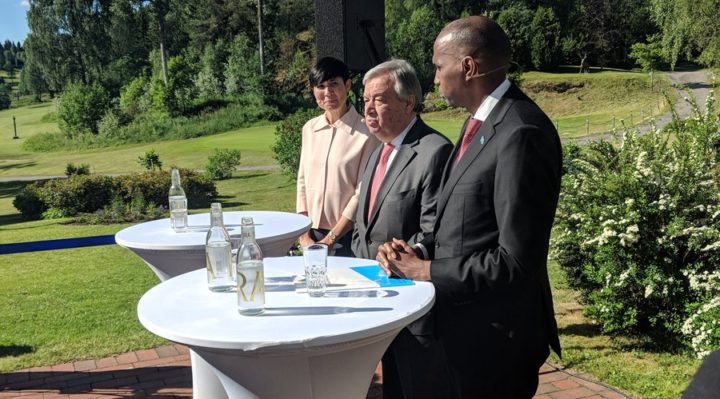 The number of countries involved in “violent conflicts” is the highest in 30 years, while the number of people killed in conflicts has risen tenfold since 2005, the U.N. secretary-general said Tuesday.
The number of countries involved in “violent conflicts” is the highest in 30 years, while the number of people killed in conflicts has risen tenfold since 2005, the U.N. secretary-general said Tuesday.
 The State Minister’s visit coincides with the arrival of the Norwegian research vessel Dr. Fridtjof Nansen to Sri Lanka. The research vessel will arrive in Colombo on the 21st of June followed by a 26 days research journey around the island. The research vessel will assist Sri Lanka in mapping her marine resources.
The State Minister’s visit coincides with the arrival of the Norwegian research vessel Dr. Fridtjof Nansen to Sri Lanka. The research vessel will arrive in Colombo on the 21st of June followed by a 26 days research journey around the island. The research vessel will assist Sri Lanka in mapping her marine resources.
 A letter written by Marina Nemat, a Canadian rights activist, writer and chair of the Oslo-based Vigdis Freedom Foundation (VFF) to Turkish journalist Ayşenur Parıldak, who is serving a seven-and-a-half-year prison sentence on charges of membership in a “terrorist” organization, was released by the foundation on Friday.
A letter written by Marina Nemat, a Canadian rights activist, writer and chair of the Oslo-based Vigdis Freedom Foundation (VFF) to Turkish journalist Ayşenur Parıldak, who is serving a seven-and-a-half-year prison sentence on charges of membership in a “terrorist” organization, was released by the foundation on Friday.
 United Nations Secretary-General António Guterres has admitted that the UN was not equipped to deal with the Sri Lanka war.
United Nations Secretary-General António Guterres has admitted that the UN was not equipped to deal with the Sri Lanka war.
 When news broke in the Norwegian press in December identifying the buyer of one of Oslo’s most iconic buildings, journalists began calling. They were desperately trying to get a comment from Ivar Tollefsen, the buyer of the building, which was the former U.S. embassy, designed by the same architect who did the Gateway Arch in St. Louis. But he couldn’t be reached that day, nor for the next week. According to a spokesperson, Tollefsen was stuck in bad weather on a mountain face off Gessner Peak in Antarctica, where temperatures drop as low as -22 °F.
When news broke in the Norwegian press in December identifying the buyer of one of Oslo’s most iconic buildings, journalists began calling. They were desperately trying to get a comment from Ivar Tollefsen, the buyer of the building, which was the former U.S. embassy, designed by the same architect who did the Gateway Arch in St. Louis. But he couldn’t be reached that day, nor for the next week. According to a spokesperson, Tollefsen was stuck in bad weather on a mountain face off Gessner Peak in Antarctica, where temperatures drop as low as -22 °F.
 Norway’s government may ask the US to extend a Marine Corps deployment in the country, Foreign Minister Ine Eriksen Soereide
Norway’s government may ask the US to extend a Marine Corps deployment in the country, Foreign Minister Ine Eriksen Soereide 
 On January 15 a Boeing 787-9 Dreamliner flying from New York’s JFK airport to London Gatwick set a new journey speed record. The aircraft, owned by budget airline Norwegian, completed its 3,470 mile journey in five hours and 13 minutes. In doing so, it became the
On January 15 a Boeing 787-9 Dreamliner flying from New York’s JFK airport to London Gatwick set a new journey speed record. The aircraft, owned by budget airline Norwegian, completed its 3,470 mile journey in five hours and 13 minutes. In doing so, it became the